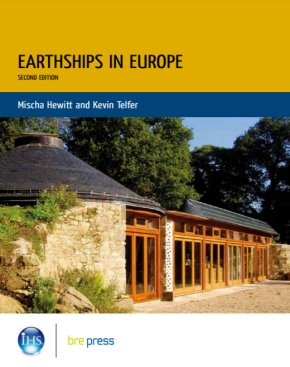Earthships in Europe
BRE (Building Research Establishment) is an independent, research-based consultancy, testing and training organisation, operating in the built environment and associated industries.
On 28 February 2012, BRE published Earthships in Europe (EP 102) (second edition) written by Mischa Hewitt and Kevin Telfer.
This 184-page book provides a detailed description and evaluation of ‘earthships’, an American architectural concept pioneered in the New Mexico desert. Earthships suggest that people can be both more financially free and more socially responsible.
The main purpose of the book is to assess whether the translation of earthships to a European setting has been successful. It includes case studies of people who have built earthships in France, Spain and Britain and a round-up of other projects. It also includes analysis of detailed monitoring of an earthship. This analysis is used to make a series of design recommendations to help make earthships more effective in different climatic conditions.
The book concludes by predicting the likely future of earthships in Europe - whether they will become a model for large-scale low-carbon housing or remain the preserve of a few self-builders.
Its contents includes:
- Preface.
- Introduction.
- What is an Earthship?
- Construction methods.
- Building with waste.
- Renewable energy and power systems.
- Water.
- European builds.
- Passive solar design and monitored thermal performance.
- Conclusion: the future of earthships in Europe.
- Appendix 1. Earthship Brighton sensor summary.
- References.
- Index.
[edit] Related articles on Designing Buildings Wiki
- 100 Sustainable Scottish Buildings.
- BRE articles on Designing Buildings Wiki.
- BRE Buzz articles on Designing Buildings Wiki.
- BRE Buzz.
- BREEAM.
- Building Research Establishment.
- Carbon ratings for buildings.
- Cob building.
- Code for sustainable homes.
- Do green buildings pay?
- Earth building.
- Home quality mark.
- Sustainability.
- Sustainable building.
- Zero Bills Home.
- Zero carbon homes.
- Zero carbon non-domestic buildings.
Featured articles and news
A change to adoptive architecture
Effects of global weather warming on architectural detailing, material choice and human interaction.
How big is the problem and what can we do to mitigate the effects?
Overheating guidance and tools for building designers
A number of cool guides to help with the heat.
The UK's Modern Industrial Strategy: A 10 year plan
Previous consultation criticism, current key elements and general support with some persisting reservations.
Building Safety Regulator reforms
New roles, new staff and a new fast track service pave the way for a single construction regulator.
Architectural Technologist CPDs and Communications
CIAT CPD… and how you can do it!
Cooling centres and cool spaces
Managing extreme heat in cities by directing the public to places for heat stress relief and water sources.
Winter gardens: A brief history and warm variations
Extending the season with glass in different forms and terms.
Restoring Great Yarmouth's Winter Gardens
Transforming one of the least sustainable constructions imaginable.
Construction Skills Mission Board launch sector drive
Newly formed government and industry collaboration set strategy for recruiting an additional 100,000 construction workers a year.
New Architects Code comes into effect in September 2025
ARB Architects Code of Conduct and Practice available with ongoing consultation regarding guidance.
Welsh Skills Body (Medr) launches ambitious plan
The new skills body brings together funding and regulation of tertiary education and research for the devolved nation.
Paul Gandy FCIOB announced as next CIOB President
Former Tilbury Douglas CEO takes helm.
UK Infrastructure: A 10 Year Strategy. In brief with reactions
With the National Infrastructure and Service Transformation Authority (NISTA).
Ebenezer Howard: inventor of the garden city. Book review.
Airtightness Topic Guide BSRIA TG 27/2025
Explaining the basics of airtightness, what it is, why it's important, when it's required and how it's carried out.























